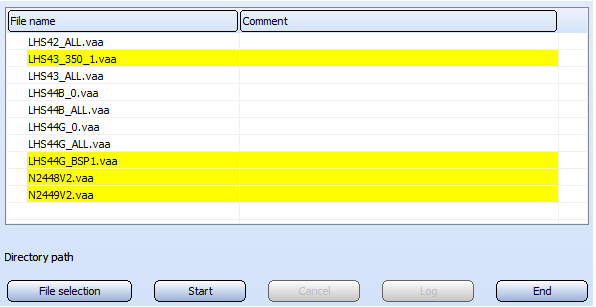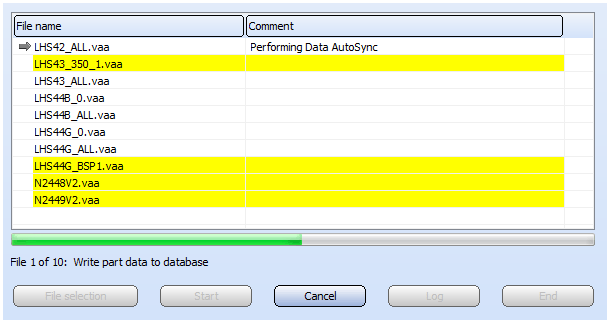Part Data Synchronisation
Drawing > Save/Reference > EditCL  > Part data synchronisation
> Part data synchronisation 
You only use this function if you want to manage parts and variants via the HELiOS Database. In this case, you can use the function to enter the sub-types of a part saved as variant into the HELiOS database, or to perform a data synchronisation between the variant and the corresponding database entries.
When you call the function for the first time, the window with the settings shown below will be displayed. When you change the settings, the changes will be saved in the Windows Registry and will be applied after restarting HiCAD.

Proceed as follows:
- Define the desired settings for data synchronisation.
- Select the files for which you want to perform the synchronisation.
- Start the part data synchronisation.
 For the synchronisation of Plant Engineering variants please use the same-named function in the Part Data Tools function group of the Plant Engineering tab.
For the synchronisation of Plant Engineering variants please use the same-named function in the Part Data Tools function group of the Plant Engineering tab.
Setting options
(1) Type of file selection
In this field you specify how you want to select the file(s) for which you want to perform the data synchronisation. You can only select a file via the database if corresponding data records already have been entered there. If this is the case, the file can even be selected from the Vault Server.
The Plant Engineering mode checkbox will be inactive here.
(2) Create log files
If this checkbox is active, a log file will be created about the part data synchronisation (recommended!).
(3) Always open article master mask/document master mask
If the Always open article master mask checkbox is active, HiCAD always opens the article master mask of the part to be processed. In this mask you can check and modify the values of the part attribute.If the checkbox is not active, the article master mask will not be displayed, if all required data can be taken from the file and from the Registry. The part master mask will however be displayed, if derivations of the part variant exist in the database.
If the Always open document master mask checkbox is active, HiCAD always opens the document master mask of the part to be processed. In this mask you can check and modify the values of the document attributes.
If the checkbox is not active, the document master mask will not be displayed, if all required data can be taken from the file and from the Registry. The document master mask will however be displayed, if any mandatory attribute values are still missing (check out these attributes in the in the corresponding part type file Documentinspect.inspect.txt in the \hicad\PlantParts\PartInspect subdirectory).
The last used value of the document attribute DOCUMENT_TYPE will be saved (in the Registry) . The saved value will be automatically applied to next part file.
The document attribute BENENNUNG (DESIGNATION) automatically obtains the value of the part attribute DESIGNATION, if the part file contains such value.
(4) Always allow use of existing part masters
Activate this checkbox if you want to use already existing part masters when synchronising part variants (VAA files) with the HELiOS database. For further information please read the information given in the topic Part Data Synchronisation - Use Existing Part Masters.
(5) Request part workflow/document workflow
If these checkboxes are active, (Part and/or Document), HiCAD requests for each newly entered part the corresponding workflow name. If this checkbox is not active, this will happen only if no workflow name has been saved yet.
If you have selected a workflow name, it will be saved (in the Registry). It will then become the default workflow (see 7). This setting will apply for all newly entered parts until you select a new workflow.
If the corresponding part already exists in the database, its workflow names have already been fixed. If no workflow names had been defined, they will be taken from the part and displayed in area (7)
(6) Part/Document workflow
Here you specify the workflow name that will be used for each newly entered part, if the corresponding options have not been activated in area (6).
(7) List
If you click the List button, a dialogue window showing you a list of all database part attributes will be displayed. You can select or deselect individual list items by activating or deactivating the corresponding checkboxes.
The selected attributes will be excluded from the part data synchronisation, i.e. for each of these attributes the following applies:
- If the VAA archive file contains a value for this attribute, it will not be used.
- If the article master of the general type contains a value for this attribute, it will not be copied to the article masters of the part subtypes.
When the dialogue opens, the list will always be sorted in such a way that the marked attributes will appear, in alphabetical order, on top of the list. All other attributes follow further down the list, also in alphabetical order. You can update this type of sorting at any time, by clicking the Sort button, for example after activating the checkboxes of other attributes.
If you select Default, the checkboxes will only be (or remain) activated for the attributes that absolutely need to be excluded. However, this does not necessarily mean that your special HiCAD / HELiOS environment will not require the exclusion of further attributes. This applies, for example, to ERP interfaces. If you are not sure about the correct setting, please contact your database administrator. These settings require particular care, as an incorrect selection of excluded attributes can destroy attribute values during the synchronisation process that had already been automatically set by HELiOS !
If you select Cancel, you will exit the dialogue without changing the selection of excluded attributes.
Clicking OK applies the changes after confirmation of a security prompt.
The names of the excluded attributes will be saved to the file ExcludedAttributes.dat in the directory <Part_path >\ PartDataAutoSync. <Part_path> stands for the directory path specified at position 6: in the file Filegrup.dat. If this path points to a server that is commonly used by all workstations, the excluded attributes will be identical for all workstations.
(8) File name and Comment
Select files
Click the File selection button and select the file(s) for which you want to perform a part data synchronisation. The type of file selection has already been determined by the setting in area (1) (see above). The selected files will then be displayed in a table.
Rows containing files for which a document master already exists in the database, will be highlighted in yellow colour. If you right-click a row highlighted in yellow, a context menu will be displayed, enabling you to
- display the document master,
- completely delete the data belonging to the file from the database (this option is not available if the file is located in the Vault Server),
- remove the file name from the table

If you right-click a non-highlighted row, the context menu will only offer the option to remove the file name from the table.
Perform part data synchronisation
Click the Start button to start the part data synchronisation for the files listed in the table. If required or trigged by the settings described above, the document master mask and/or the article master mask for the currently processed file will be initially displayed, either for checking purposes, or to enable the entering of missing attribute values. After closing the mask with OK, the part data synchronisation will be performed for the corresponding file in the list.
The currently processed file will be marked with an arrow symbol in the list. The progress bar refers to the processing of this file. A text line is shown below, informing you about the currently performed action.
If you click Cancel, the processing of the file that is currently marked with the arrow symbol will still be completed. The files that follow on the list will however not be processed any more.
The icon in the first column on the list and the information given in the Comment column indicate whether the part data synchronisation for the corresponding part was successful, or if any errors occurred.
After completion of the part data synchronisation, you can display a Log about the process. Click End to end the program.

Create Feature Variant (3-D) • Variant Editor • Referencing Functions (3-D) • Variants - Example (3-D)





